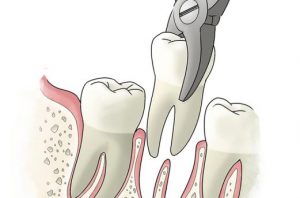Table of Content:
- What should I expect following tooth extraction surgery?
- Do’s and dont’s following tooth extraction
- What happens if you don’t follow post-op instructions?
- When is your next appointment?
What should I expect following tooth extraction surgery?

You will experience some pain and swelling after tooth extraction. Pain level varies based on the complexity of the surgery, the condition of your body, the thickness of your jawbone, etc. Here are a few additional tips to help you recover from your surgery:
- Take it easy and get as much rest as possible. The first 2 to 3 days are the most critical ones.
- Place an ice-pack on the surgery site. Apply the ice pack for 15 to 20 minutes on-and-off. Do this during the first day or two to keep the swelling down and reduce the pain.
- Sleep with your head slightly elevated.
- Rinse with warm salt water. Use 1 teaspoon salt added to 8 oz of water. Rinse anywhere from 2 to 3 times to about 4 to 5 times a day. Continue this routine for the next week as your gums continue to heal.
- Be sure to take your medications as prescribed. Antibiotics must always be finished. Take the painkillers for as long as you experience pain. You may stop taking your painkillers once the pain is gone.
Do’s and dont’s following tooth extraction
The first two to three days following your tooth extraction are the most uncomfortable ones. It’s important that you follow post-op instructions carefully to heal quickly and minimize complications. Here are some things to watch out for during the first few days after surgery:
Apply firm pressure to the extraction site
You will be given several gauzes to apply pressure to the surgery site. Remove this gauze every 20 minutes and apply fresh ones. Repeat this process until the bleeding stops or minimizes. Alternatively, apply a wet tea bag to the surgery area. The theine in tea bags is effective at stopping the bleeding. If the bleeding continues for more than 5 hours, or if you are bleeding profusely, you must contact your dentist immediately. If you can not get a hold of your dentist then you must go to the nearest emergency room. This is particularly a concern if you’re on blood thinners or suffer from uncontrolled high blood pressure.
Modify your diet
Drink plenty of fluids over the next few days. Eat soft foods and avoid chewing on the tooth extraction site as much as possible. Avoid foods with small kernels, like nuts or popcorn, so that they don’t get stuck in the fresh extraction site. As the hole starts to close up in the next few days, you can begin to chew on the surgery side again.
Minimize your oral hygiene
It’s okay to skip cleaning the surgery site for the first couple of days. You should get back to your normal brushing routine about a week following surgery (except for complicated wisdom teeth which require two weeks).
Don’t play with it!
Leave the extraction site alone so that it heals better. Playing with it can dislodge the blood clot and postpone your healing process. No rinsing, no spitting, and no drinking through a straw. Avoid any kind of suction or blowing action for 2 to 3 days following your surgery.
Don’t smoke
No smoking or use of tobacco products for at least 48 hours following tooth extraction. Nicotine is extremely detrimental to the healing process because it slows blood flow to the extraction socket. Unfortunately, heavy smokers will typically experience more pain and discomfort following tooth extraction surgeries. Stop smoking a week before and a week after your tooth extraction surgery. This allows your body to produce fresh, high-quality platelets that improve the healing times of your surgery site.
Take your medicine
Take your antibiotics and pain medications as prescribed. It’s best to take your medicine with food to avoid an upset stomach. Take your first dose as soon as possible after surgery. This way, you will feel the effects of the medicine by the time your anesthesia has worn off. Be sure to finish all of your antibiotics and take them on schedule. You can stop using your painkillers once the pain is gone.
What happens if you don’t follow post-op instructions?
If you don’t follow these instructions, there’s a chance that you won’t form a proper blood clot. This may lead to severe pain, excessive bleeding, and a delayed healing process. In the worse scenario, this leads to a dry socket. A dry socket occurs when there is poor healing at the surgery site. Dry sockets are usually very painful and last for several weeks. There is no treatment for a dry socket and you will have to deal with the pain and discomfort for the next few weeks. Follow the post-op instructions to minimize your chances of ending up with these types of complications.
When is your next appointment?
Most dentists want to see you back within one to two weeks after your surgery. During your post-op appointment, they will remove any left over sutures. They will evaluate your healing process and they make take X-rays if necessary. Don’t panic if your sutures loosen before your scheduled appointment. Sutures are only important for the first few days after surgery. It’s typically okay if your sutures become loose before your next checkup appointment. So long as there are no signs of infection or severe pain, you’re doing fine. Be patient, as the full healing process takes several weeks, sometimes even longer. If you have any other questions or concerns, contact your dentist or oral surgeon for further instructions.